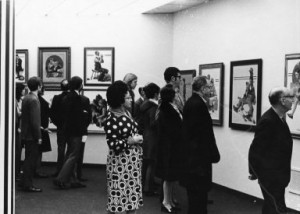History Continues with the Cold War, Vietnam, and Early Apple Computer Kiosks
This is the final post in a tour through the Museum’s historical exhibition press releases, taking us up to the 1980s. If you’ve enjoyed this peek into history, you’re encouraged to visit the Museum’s Exhibitions database, where you can browse by decade (among other search options). And make sure to check out the jpgs of the original releases, which are at the bottom of each entry.

U.S.S.R. Technical Books. Installation view. Brooklyn Museum Archives. Records of the Brooklyn Museum.
At the height of the Cold War, shortly after the 1962 Cuban Missile Crisis, U.S.S.R. Technical Books came to the Museum as part of an early Soviet-American cultural exchange program. It showcased Soviet science, industry, and medicine using manuals, textbooks, journals, and films, and included “documentaries on Yuri Gagarin’s orbital flight, thermonuclear research and new Soviet surgical techniques.” According to the release, the exhibition “cannot fail to promote understanding between the American and Soviet people.”

Norman Rockwell: A Sixty Year Retrospective. Installation view. Brooklyn Museum Archives. Records of the Department of Paintings and Sculpture.
The political and cultural upheaval of the late 1960s and early 1970s—and the ensuing nostalgia for “small town America … of a bygone, happier time”—is alluded to in the 1972 release for Norman Rockwell: A Sixty Year Retrospective, the first major exhibition of his original paintings. “Today, young America, of the long-haired, blue-jeaned Now generation, is discovering Norman Rockwell.”
Also during the early 1970s, the prolonged Vietnam War was starkly documented with an exhibition of work by nine photojournalists who were either killed or missing in action covering the war. The images in Viet Nam: A Photographic Essay “graphically depict the brutal face of war. Mounted without captions and numbered for identification purposes only, the pictures speak for themselves.”

Viet Nam: A Photographic Essay. Installation view. Brooklyn Museum Archives. Records of the Department of Prints, Drawings, and Photographs.
Using original plans drawn by John A. Roebling, historical and contemporary art works, and early digital technology, The Great East River Bridge: 1883-1983 celebrated the centennial of the Brooklyn Bridge. “A computer program demonstrating the building of the bridge which has been created expressly for this exhibition by the Apple Computer Incorporat[ed], perpetuates the iconography of the bridge in modern day technology.” For more on this exhibition, including photos and essays from the catalogue, check out the Museum’s Research pages.

The Great East River Bridge: 1883-1983. Installation view. Brooklyn Museum Archives. Records of the Department of Education.

Anya is an editorial assistant in Publications and Editorial Services, helping to maintain the Museum's web content. She has a background in publications and project administration with a focus on nonprofit organizations, the visual arts, environmental activism, and grantmaking. When not at the Museum, she does freelance newspaper writing and copyediting in her neighborhood of Williamsburg-Greenpoint, volunteers refurbishing bikes, plays guitar and violin, and looks after two rabbits.
